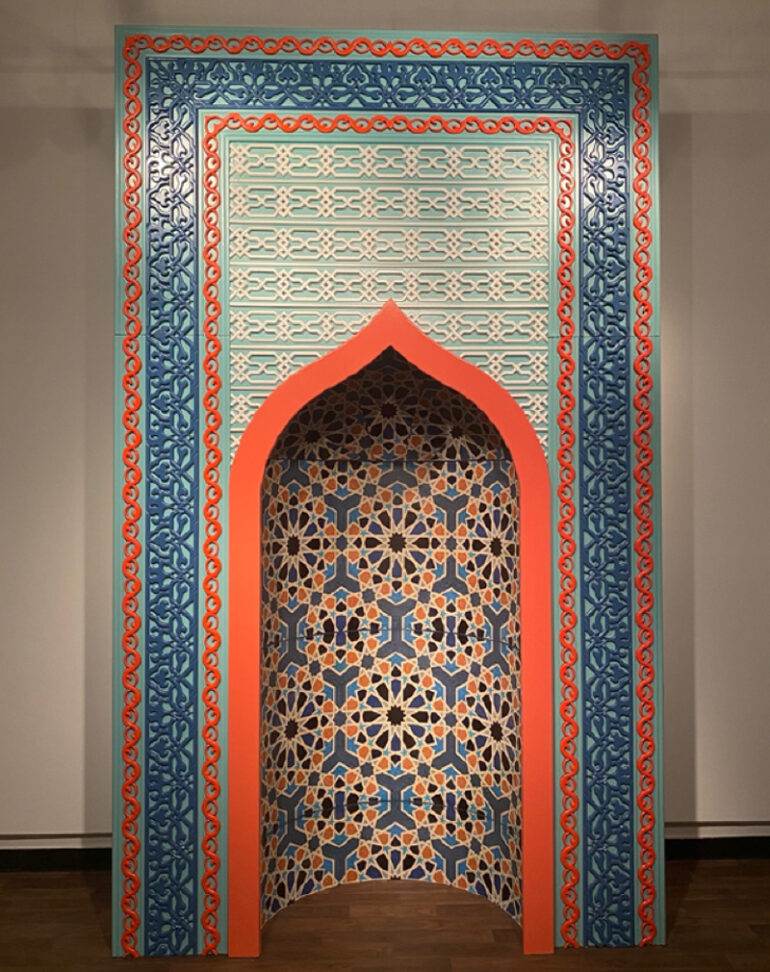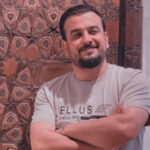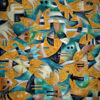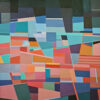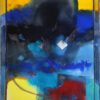The current situation suggests something to the effect that the capitalism dominance has further infiltrated so it took over and predominated all aspects of our life, including personal matters, not to mention the public areas of life. Stemming from that, we could fathom that there is no way out of that dominance but with liberation, aiming to use the tools of criticism, resistance, and revitalization of everything that’s unique and unmeasured by their rules. This is particularly clear in our hypothesis for art being the critic, the resistant, and the unique. As art is wanted to be a dam on one side and a bridge on the other. A dam in the face of the subsequent crushing waves of capitalism, and a bridge toward a human life attired in hope for happiness and freedom. To test our hypothesis and the problem I’m posing in this article, I’ll be considering scholars from the German Critical Theory in Frankfurt as diagnostics and therapeutic models along with art.
Theodor W. Adorno: Art and Industrialized Culture
Adorno introduces a lot of special concepts within the aesthetical fields, and tries to unravel the extents of reification and alienation within works of art, trying to filter them out of their transcendences and metaphysics, and assign them the role of carrying the burdens of reality and humanity, so it can contribute to creating liberty. Adorno also sees in culture an extra room for affectation, consumerism, and dominance, along with the forcing acts of cultural industry, marked by suppressing the different and producing totalitarianism, leading to the absence of any distinction in the fields of labor and work, and even looks. Production now “confines itself to standardization and mass production and sacrifices what once distinguished the logic of the work from that of society” 4
Adorno sees that liberating humans from dominance cannot be achieved via public protests, liberation, or revolutionary movements, but only through authentic art that contains in itself the capability to demolish and extirpate. He sees that art, not science, is the greatest and the one true knowledge, for science is partial and can only reflect the dominant and established facts.
In their book “Dialectic of Enlightenment”, Adorno and Horkheimer diagnose the continuation in which “The culture industry endlessly cheats its consumers out of what it endlessly promises. The promissory note of pleasure issued by plot and packaging is indefinitely prolonged: the promise, which actually comprises the entire show, disdainfully intimates that there is nothing more to come, that the diner must be satisfied with reading the menu.” 5 The aim of the previous diagnosis is to search for an exit and escape its subjugation of human conduct.
The capitalist society, according to Adorno, utilizing its connections in the cultural industry, has subsumed everything to be “Perceived only from the point of view that it can serve as something else, however vaguely that other thing might be envisaged. Everything has value only in so far as it can be exchanged not in so far as it is something in itself.” 6 These attempts try to restore the human, break his technical chains and destroy them. His restoration and breaking out of that prison can only be achieved by acquiring the power of imagination and exploiting its artistic role “Because when imagination provides a picture, it is invoking a conscious vision of reality, such vision could surpass the repressed and the suppressed, thus fulfilling its cognitive purpose. Imagination leads us to Aesthetics, and behind the Aesthetical picture, we can find the harmony between love and the imaginative mind that was repressed by the concept of revenue… Art is the return of what was repressed with its beauty at its finest,… it is because artistic imagination provides the implicit memory with the image of liberty that was suppressed by the laws of reality, which only care about the immediate materialistic revenue.” Imagination would later constitute the most important foundation, on which the intellectuals of the Frankfurt School would rely, especially with what we will see with Herbert Marcuse.
Referring to Self might be criticized in liberation, because it has to be a subjective process in most contemporary ideologies such as Scientism and Positivism. However, Adorno finds a resort and an escape in referring to self, because it is the one entity that is able to provide us with salvation, he says “It might be said that under present conditions the subject is both: on one hand, ideology;… on the other, however, the subject is also the potential, the only potential, by which this society can change… but it should be added that recognition of the reification of society should not itself be so reified that no thought is permitted which goes outside the sphere of reification – that would lead to mechanistic thinking” 7
All of that paints a picture of Adorno’s methodology in his criticism theory as being the main role of philosophy. According to him, it is the act of performing a critical review in the face of forced rationalization; instrumentalism, bureaucratic, and technical rationalizations. Those are the three manifestations of an Authoritarian, determinate, and hegemonic topic in which humanism dignity and freedom become alienated. This is the point of his “Negative Dialectics” project. Instead of the total founding of a view on society, he resorted to dialectic being a criticism of different philosophical and social theories. This methodology has led to denying the possibility of having an absolute reference and starting point or any primary foundation for human thinking. With that, any totalitarian or wholistic approach is prone to be criticized and hammered. This is Adorno’s new hammer, but it is not destructive as much as it is corrective and critical, leaning towards aesthetics and inner-humane dimensions. However, Adorno maintained the socially engaging historical determinism when it relates to “what has become” and what governs and controls the actions of humans. He mentions that “the ability to perceive what has become in something which presents itself as merely being; just as it is one of the essential faculties of a critical theory of society to grasp things which purport to be existent and thus given by nature in terms of their having come to be… and it manifests itself in a still more radical sense: in the sociological law… without needing to resort to the no less famous distinction between the nomothetic and the idiographic, which, of course, is questionable, from the sociological perspective, since such things as social regularities do self-evidently exist. But these social regularities differ constitutively from those of the natural sciences through the form of their own historicity.” 8 This summarizes how Horkheimer and Adorno explored the depths of the critical theory by diagnosing the drivers of society, and what is subjected, consciously or unconsciously, to reification. They were in search of salvaging humans from it, by means of imagination, dialectic, and art, in critical frameworks, thus, accomplishing huge favors for the humanism thinking, and the human self in general.
The Way Out of Authoritarian Reification: Art, Imagination, and Solidarity
Marcuse believes that the aesthetics dependence on a legitimate imaginary dimension has been suppressed with technology and the broader system of capitalism and what instrumentalism and observation have produced in the theoretical and applied sciences. It distorted the achievements of the mind and did not allow the power of the imagination to become practical, or to meet its destiny in practice. The practicality of imagination lies in the possibility of creating new ethics and a new system of freedoms and rights, while adhering to what reason accepts rather than to superstitions. Therefore, contemporary political protests are a form of imagination and liberation that its resistance paints an aesthetic dimension and produces a new morality and sensitivity to the existing humanitarian situation, which are both conditions and consequences for social change.
The basic feature of a liberated society is solidarity, and it works to create harmony in human relations, with regard to labor and its goals. Through it, a person can express the appropriateness of the needs of the individual and society and its goals. This is what will lead towards the new concept of freedom that depends on one’s feeling of being free and independent. This is clear by understanding that what relations produce is exactly what is desired, and because it is subject to the criterion of solidarity and social service, which is also its own creation.
Habermas, critique of instrumentalism and the use of art:
In most of his work, Habermas focused on the quest of finding suitable standard bases for a social critical theory, and reconstructing the concept of rationality, especially social rationalization. He criticizes the reversion of rationality to a mere pure calculator, he also tried to build a concept that allows for a better understanding and criticism of the one-sided social rationalization that characterizes the growth of capitalism. As there is an increasing tendency in society to marginalize the conscious, normative and aesthetic concepts in favor of the technical one, and he attempts in his readings of Weber’s theory of rationalization as a part of the revision of modernism, by identifying the features of the negative aspects of modernism that result from the reflection on social practices; it is therefore imperative (to adopt a more complex concept of rationality) where we can be helped to understand the fields that open up the rationality of the world’s perceptions, as it was reached in the West, on modernizing society, and only on this basis can the process of rationalizing the systems of practice be analyzed in its extensions, not from the limited angle of what is cognitive-instrumental, but rather by introducing the ethical-practical and aesthetic-expressive dimensions. Therefore, the aesthetic subject and the means of its production are considered resistance to what is quantitative, arithmetic, technical and instrumental.
Understanding with Gadamer: Towards a faithful artwork
“Understanding is a matter of intellectual brilliance in the form of practical wisdom or real culture”. 9 The goal of abandoning scientism takes theoretical directions according to Gadamer, the first is in understanding history, and the second is in understanding a work of art. Gadamer crosses out the boundaries that separate subject from object. He applies this to the subjects of history and art. In history, we must understand that man is nothing but a juice of the mixture of heritage and modernity. Therefore, he is a product of the fusion of what is coming out of and what is inside us. Likewise, artistic work bears good tidings for us to reveal the truth outside the technical, precise, specific, and strict methods of science, because the artistic work calls to speak a truth, and since we cannot take a method as in natural science to know that truth, it provides a way out of scientism through another outlet, which is the freedom to evaluate the work and appreciate it aesthetically. Thus, the mask of scientific hegemony over knowledge falls. The work of art, in its essence, “is not separate from our world in which we live, nor from our understanding of ourselves. And so as we encounter the artwork, we do not delve into a strange world, do not step outside time and history, and do not separate from ourselves or from non-aesthetic things,… When we understand a great work of art, our experience of it interacts with our whole being, and our understanding of ourselves is placed in question.
What happens then is that we are not who interrogates the work, but the work is the one who interrogates us and lays upon us its question, it preoccupies us with the matter that preoccupied it and brought it into existence”. 10 And here is another initiative from Heidegger in the Ghadamerian ways and paths of understanding, I mean that he emphasizes the fusion of the human worlds of history, art, philosophy and others, an interference that does not separate it from its themes, but rather blends with it and even flows in it, This results in ejecting and expelling every extreme objectivity that gives space for scientism to enter as a tool and reference in the human sciences interpretations.
But has science and knowledge (meaning social, humanitarian and historical science) been able to take Hermeneutics as a “step-by-step” approach? It is no secret that this question is not new, but the responses were often non-direct answers, whereas we say: We do not have a precise approach to human science and we cannot replicate the experience on natural science, that is the answer.
Based on the foregoing, science and knowledge outside the circle of natural science calls for the idea of wandering around, and what I mean by “wandering” is not to stop at the beginning and end of the curriculum, or to not map out the way to get to the truth with these technical fences of natural and mathematical science.
The human sciences call for the “philosophy of wandering”: wandering around the halls, roads and paths in order to benefit its subject. Wandering also invites us to understand the idea of a circular vacuum without stopping on a determined asset. This is the nature of hermeneutics as other movements and contemporary philosophical methodologies.
The intrinsic character of the wandering philosophies is the permanent nomadism, it is a new desert and nomadic in the lands of meaning. The more you gather oases or wells to feed the question, the meaning dwells a little to draw from it.
However, if those deserts are considered a “methodology” (even arguably), then that’s the course of the human science. All of the above is characteristic of the denaturalized post-modernist style of art, which has been labeled as a pleasure ideology: because postmodernism ideology appears to be in mere defense of the metaphysical heritage, and overcoming the functional conception of ideology towards a realistic scientific ideology, as real as it could be, it takes the form of a liberating act with aesthetical, artistic, and moral dimensions.

4 Horkheimer, Max, and Theodor W. Adorno. 1982. Dialectic of enlightenment., Page 95.
5 Horkheimer, Max, and Theodor W. Adorno. 1982. Dialectic of enlightenment., Page 111.
6 Horkheimer, Max, and Theodor W. Adorno. 1982. Dialectic of enlightenment., Page 128.
7 Adorno, Theodor, Introduction to Sociology, 1968, Page 152.
8 Adorno, Theodor, Introduction to Sociology, 1968, Page 147.
9 Mohammed Chaouki Zine: “Displacement and Probability”, Arab scientific publisher, 2008, p. 82.
10 Adel Mustafa: “ Understanding the Understanding : An Introduction to Hermeneutics”, Dar Al-Nah-da Al-Arabiya, Beirut, 2003, p. 201.
Professor of Contemporary Philosophy at the College of Arts - the University of Baghdad, founder and Chairman of the Arab Academic Association for Philosophy.

